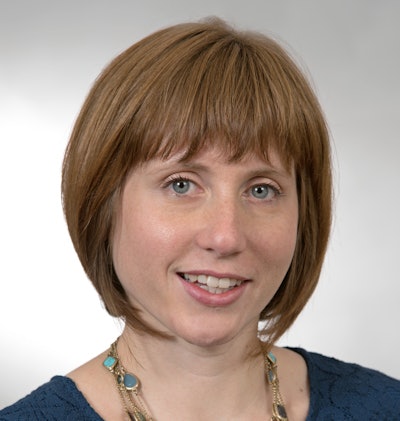
Almost half of primary care providers (PCPs) don't feel prepared to respond to patient questions about breast density, according to a study published online January 17 in the Journal of Women's Health.
 Christine Gunn, PhD, from BMC.
Christine Gunn, PhD, from BMC.
The findings suggest a disconnect between the intention of this type of legislation and its practical effect, particularly on primary care providers, who are at the forefront of decision-making with patients who receive these notifications, wrote a team led by Christine Gunn, PhD, from Boston Medical Center (BMC).
"Despite the widespread adoption of [breast density] legislation, little is known about its impact on clinical practice, and the consequences of [it on primary care providers] have only been minimally explored," the group wrote.
Clear as mud?
Currently, 32 states have passed some form of breast density notification legislation, and a federal measure continues to be discussed in Congress, according to the researchers. But there's controversy over the bills, due in large part to a lack of professional guidelines to support the use of supplemental screening, Gunn told AuntMinnie.com.
"Dense breast notification laws are intended to promote shared decision-making among providers and patients, but is that really happening?" she said. "This kind of legislation can create significant downstream work for primary care providers, and if they don't feel there's good evidence to support supplemental imaging, it's not surprising that they would find it challenging to discuss density and additional imaging options with patients."
To investigate the attitudes about and knowledge of Massachusetts dense breast notification legislation among practitioners, as well as its effect on clinical practice after it was enacted in 2015, Gunn's group used an anonymous online survey sent to PCPs and nurses at two urban hospitals between 2015 and 2016. The team received 80 surveys, for a participation rate of 55%.
Eighty percent of survey participants had some familiarity with the legislation, but none identified the eight required components of the notification that Massachusetts legislation requires, the researchers noted. Other findings were as follows:
- Although 42% of survey participants stated that the legislation has changed their discussion of mammography results with patients, 49% did not feel prepared to respond to patient questions about dense breast tissue and supplemental imaging.
- 41% were aware of evidence for supplemental screening.
- 85% indicated interest in further training/education on how to manage patients with dense breast tissue.
- 49% of female providers were in favor of the legislation, compared with 11% of male providers.
- 76% of providers with fewer than five years of experience were in favor of the legislation, compared with 9% of providers with more than 20 years of experience.
"[Our results] suggest that providers have limited knowledge about the [Massachusetts] legislation and few perceive it will have the intended effect of promoting informed decision-making for patients," the authors wrote. "While most had at least some familiarity with the legislation, none was able to identify all eight required components of the notification and half of PCPs did not feel prepared to respond to patient questions about dense breasts."
It takes a village
As outcomes related to supplementary screening for dense breasts continue to be studied, providers can help patients weigh the benefits and risks of these additional exams on an individual basis. Primary care is one venue for such discussions, but this kind of patient interaction and education is the responsibility of a variety of physicians -- including radiologists.
"A range of specialties should be prepared to engage in these discussions," Gunn and colleagues wrote.
Boston Medical Center has established a breast specialty clinic that brings together a multidisciplinary team with radiologists, surgeons, and primary care providers trained in breast health, according to Gunn. The clinic offers PCPs a resource for their patients. But they also need better tools, she said.
"PCPs need better risk-assessment tools that are user-friendly, are integrated into their workflow, and include density as a factor," she told AuntMinnie.com.
Yet further research to establish the effectiveness of supplemental imaging is crucial to any effort to support primary care providers -- and other physicians -- as they care for women with dense tissue, Gunn and colleagues concluded.
"Until well-designed, long-term comparative studies of supplemental screening of women with dense breasts are available to guide clinical practice, dense breast notification laws will prompt mammography providers to alert women in the absence of a sufficient evidence base to guide screening decisions," the group wrote. "Evidence-based education on how to best counsel women with dense breasts using available risk-assessment tools ... may support primary care providers in states in which breast density legislation has been enacted."




















